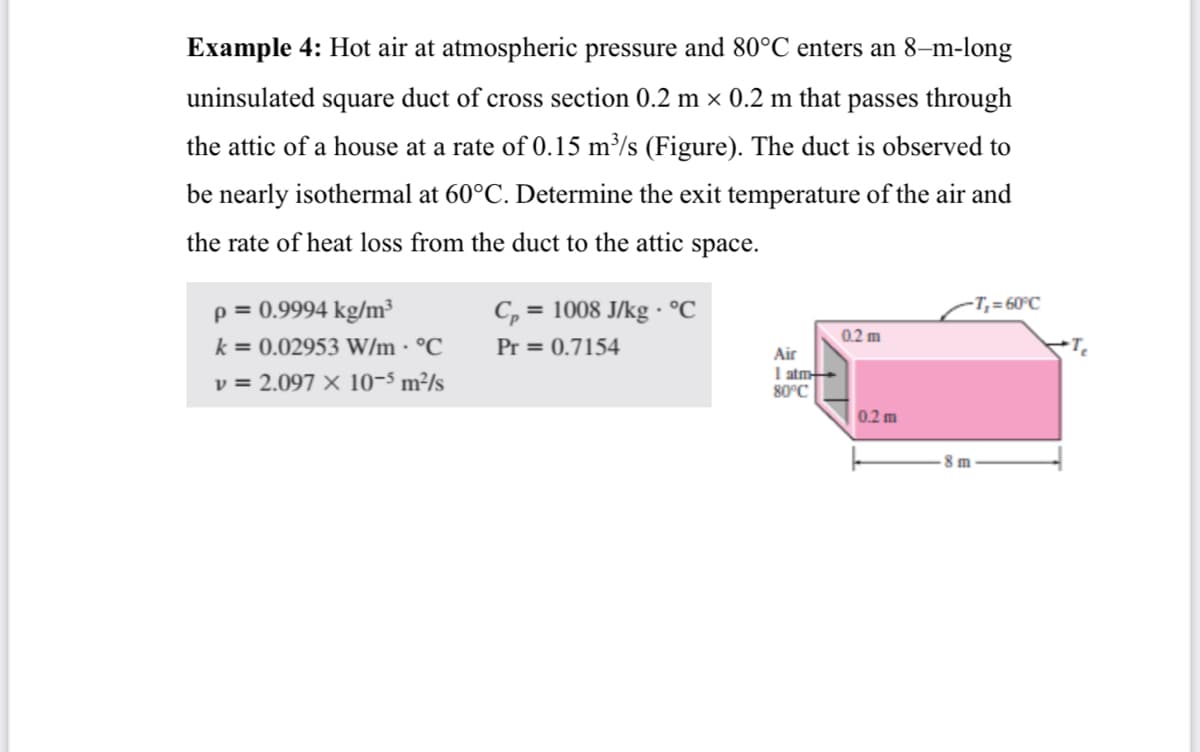Example 4: Hot air at atmospheric pressure and 80°C enters an 8–m-long uninsulated square duct of cross section 0.2 m x 0.2 m that passes through the attic of a house at a rate of 0.15 m³/s (Figure). The duct is observed to be nearly isothermal at 60°C. Determine the exit temperature of the air and the rate of heat loss from the duct to the attic space. p = 0.9994 kg/m³ k = 0.02953 W/m · °C v = 2.097 × 10-5 m²/s = 1008 J/kg · °C T;=60°C 0.2 m Pr = 0.7154 Air I atm 80°C 0.2 m 8 m
Example 4: Hot air at atmospheric pressure and 80°C enters an 8–m-long uninsulated square duct of cross section 0.2 m x 0.2 m that passes through the attic of a house at a rate of 0.15 m³/s (Figure). The duct is observed to be nearly isothermal at 60°C. Determine the exit temperature of the air and the rate of heat loss from the duct to the attic space. p = 0.9994 kg/m³ k = 0.02953 W/m · °C v = 2.097 × 10-5 m²/s = 1008 J/kg · °C T;=60°C 0.2 m Pr = 0.7154 Air I atm 80°C 0.2 m 8 m
Principles of Heat Transfer (Activate Learning with these NEW titles from Engineering!)
8th Edition
ISBN:9781305387102
Author:Kreith, Frank; Manglik, Raj M.
Publisher:Kreith, Frank; Manglik, Raj M.
Chapter7: Forced Convection Inside Tubes And Ducts
Section: Chapter Questions
Problem 7.34P
Related questions
Question
Example 4: Hot air at atmospheric pressure and 80°C enters an 8–m-long uninsulated square duct of cross section 0.2 m 0.2 m that passes through
the attic of a house at a rate of 0.15 m3/s (Figure). The duct is observed to be nearly isothermal at 60°C. Determine the exit temperature of the air and the rate of heat loss from the duct to the attic space.

Transcribed Image Text:Example 4: Hot air at atmospheric pressure and 80°C enters an 8–m-long
uninsulated square duct of cross section 0.2 m × 0.2 m that passes through
the attic of a house at a rate of 0.15 m³/s (Figure). The duct is observed to
be nearly isothermal at 60°C. Determine the exit temperature of the air and
the rate of heat loss from the duct to the attic space.
p = 0.9994 kg/m³
k = 0.02953 W/m · °C
v = 2.097 × 10-s m²/s
C, = 1008 J/kg · °C
T;=60°C
0.2 m
Pr = 0.7154
Air
I atm
80°C
0.2 m
8 m
Expert Solution
This question has been solved!
Explore an expertly crafted, step-by-step solution for a thorough understanding of key concepts.
This is a popular solution!
Trending now
This is a popular solution!
Step by step
Solved in 2 steps with 3 images

Knowledge Booster
Learn more about
Need a deep-dive on the concept behind this application? Look no further. Learn more about this topic, mechanical-engineering and related others by exploring similar questions and additional content below.Recommended textbooks for you

Principles of Heat Transfer (Activate Learning wi…
Mechanical Engineering
ISBN:
9781305387102
Author:
Kreith, Frank; Manglik, Raj M.
Publisher:
Cengage Learning

Principles of Heat Transfer (Activate Learning wi…
Mechanical Engineering
ISBN:
9781305387102
Author:
Kreith, Frank; Manglik, Raj M.
Publisher:
Cengage Learning